Jan-Luka Schmitz
Coallision
Jun 27th, 2025
– Aug 9th, 2025
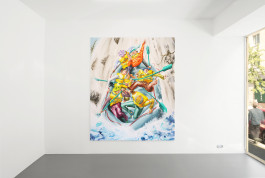
Coallision, 2025
230 × 160 cm
Acrylic on canvas
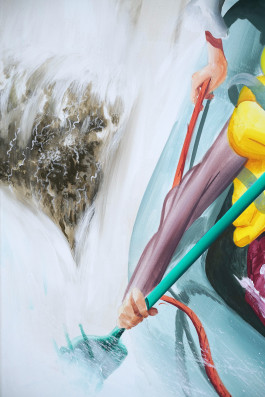
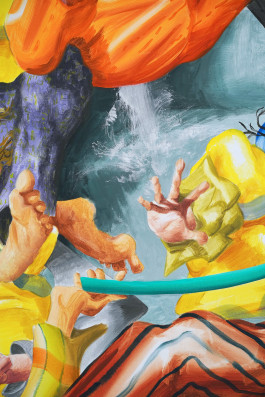
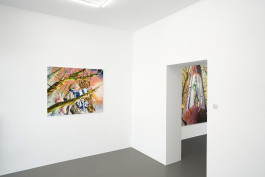
Tau & Auge, 2025
100 × 120 cm
Acrylic on canvas
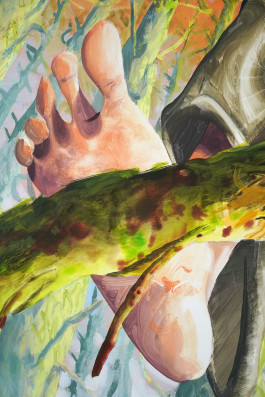
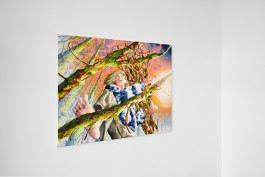
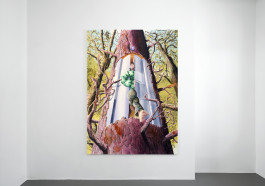
L’alberocensore II (That’s my stop!), 2025
200 × 150 cm
Acrylic on canvas
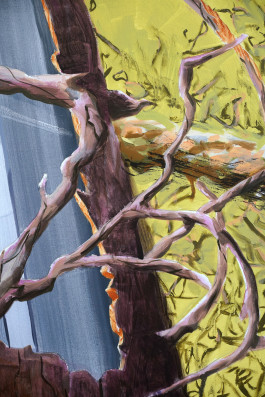
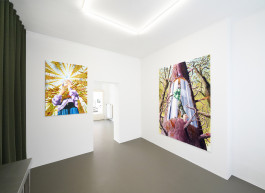
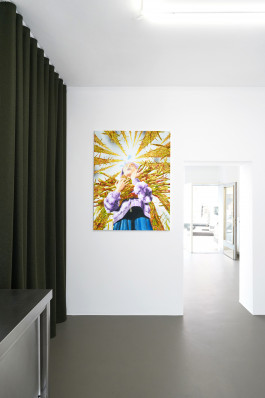
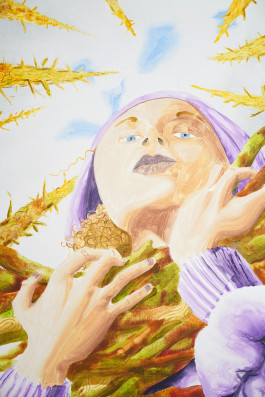
Schock & Schein, 2024
130 × 100 cm
Acrylic on canvas
Jan-Luka Schmitz’s work can easily be framed within wider socio-environmental discourses. His paintings feature nature motifs – from forests to waterfalls – and convey a sense of human struggle, leading some to read them as critiques of progress at the expense of the planet. While such an interpretation is as valid as another, viewing Schmitz’s work only through the lens of the Anthropocene flattens their complexity and overshadows more psychological, ambiguous, and formal dimensions of his practice.
Not climate change but the human condition is at the heart of Schmitz’s recent paintings. By placing stylised figures into exaggerated, absurd, or physically impossible situations, the artist creates visual metaphors for the complexity and contradictions of human experience. He uses aspects of challenge – being stuck, squished, tangled, stretched – to externalize internal states or make visible the invisible: feelings of anxiety, pain, loss of anchorage, fear of the unknown, the list goes on. The theatrical nature of the puppet- or toy-like figures adds another layer of meaning by suggesting a lack of control, as though being moved by forces beyond one’s will.
Schmitz’s paintings may seem fantastical, like fragments from an adventure tale. But beneath their whimsical surface lies deep resonance with very real ecological and humanitarian crises. However, while Schmitz is inspired by media imagery and public debates, he doesn’t translate specific events into his works. Outside influences seep in intuitively and can only be discerned in retrospect, he says. As such, Schmitz’s artistic process is not driven by clear, narrative intent but rather exploratory, responding to affect, form, mood, and unconscious associations.
The cartoonish and animated quality of Schmitz’s paintings creates a necessary distance from reality. This not only grants the works a timeless, open-ended character but also has the added advantage that the depicted content feels less immediate. Rather than forcing the viewers into direct confrontation with heavy subject matter, Schmitz invites viewers to dwell in ambiguity, metaphor, and allusion like, in the case of Coallision (2025), the ‘fall of man’. In this way, the paintings become a space of unresolved tension that doesn’t offer resolution and moral clarity but lingers in the mind, unsettling and suggestive.
Visually, Schmitz creates this unresolved pictorial tension by balancing between structure and spontaneity. The artist makes detailed sketches to establish the composition, but once he starts painting, Schmitz embraces a looser, more spontaenous style in favour of rhythm. As a result, he gives us something to hold onto and something gestural, structuring our sight while keeping the eyes moving.
Schmitz also encourages closer looking by playing with perspective. He uses photographs like aerial shots from airplanes as inspiration for motifs, creating slightly distorted, skewed scenes that evoke an uncanny atmosphere. By blurring the lines between reality and memory, he asks us to reconsider how we see and experience the world around us.
For Schmitz, the sensory experience is just as if not more crucial as the thought processes that his paintings trigger. The artist uses brushes (including toothbrushes), rags, and his gloved hands to layer, smear, and splash paint across the canvas. His tactile approach combined with the clever use of atmospheric colours which we see in works like Tau & Auge (2025) mesmerize without needing to be explained. Schmitz’s paintings don’t require interpretation to be meaningful; on the contrary, their power lies in how they affect us when simply felt.
Bio
Jan-Luka Schmitz (born 1992) lives and works in Düsseldorf. He completed his studies at the Kunstakademie Düsseldorf in 2019, studying Fine Arts under Professor Andreas Schulze. Schmitz has exhibited across Germany and Italy, including Max Hetzler gallery in Berlin, Artuner in Turin, Kunstmuseum Solingen, Kunstsammlung NRW, and Akademie-Galerie in Düsseldorf. He received several grants and scholarships (e.g. dHCS), and was shortlisted for awards such as the “Art Prize Junger Westen” (2025). He also completed a residency at the St. Moritz Art Academy in 2017.
Coallision is Jan-Luka Schmitz’s first solo show at JVDW gallery. It is also the inaugural show at JVDW gallery’s new location in Düsseldorf’s Little Tokyo district. Here JVDW gallery situates itself within a unique cultural context and enters a new phase in its program, focusing on concentrated exhibitions, performances, and applied arts.
Text: Merit Zimmermann
Jan-Luka Schmitz
Coallision
Jun 27th, 2025
– Aug 9th, 2025

Coallision, 2025
230 × 160 cm
Acrylic on canvas



Tau & Auge, 2025
100 × 120 cm
Acrylic on canvas



L’alberocensore II (That’s my stop!), 2025
200 × 150 cm
Acrylic on canvas




Schock & Schein, 2024
130 × 100 cm
Acrylic on canvas
Jan-Luka Schmitz’s work can easily be framed within wider socio-environmental discourses. His paintings feature nature motifs – from forests to waterfalls – and convey a sense of human struggle, leading some to read them as critiques of progress at the expense of the planet. While such an interpretation is as valid as another, viewing Schmitz’s work only through the lens of the Anthropocene flattens their complexity and overshadows more psychological, ambiguous, and formal dimensions of his practice.
Not climate change but the human condition is at the heart of Schmitz’s recent paintings. By placing stylised figures into exaggerated, absurd, or physically impossible situations, the artist creates visual metaphors for the complexity and contradictions of human experience. He uses aspects of challenge – being stuck, squished, tangled, stretched – to externalize internal states or make visible the invisible: feelings of anxiety, pain, loss of anchorage, fear of the unknown, the list goes on. The theatrical nature of the puppet- or toy-like figures adds another layer of meaning by suggesting a lack of control, as though being moved by forces beyond one’s will.
Schmitz’s paintings may seem fantastical, like fragments from an adventure tale. But beneath their whimsical surface lies deep resonance with very real ecological and humanitarian crises. However, while Schmitz is inspired by media imagery and public debates, he doesn’t translate specific events into his works. Outside influences seep in intuitively and can only be discerned in retrospect, he says. As such, Schmitz’s artistic process is not driven by clear, narrative intent but rather exploratory, responding to affect, form, mood, and unconscious associations.
The cartoonish and animated quality of Schmitz’s paintings creates a necessary distance from reality. This not only grants the works a timeless, open-ended character but also has the added advantage that the depicted content feels less immediate. Rather than forcing the viewers into direct confrontation with heavy subject matter, Schmitz invites viewers to dwell in ambiguity, metaphor, and allusion like, in the case of Coallision (2025), the ‘fall of man’. In this way, the paintings become a space of unresolved tension that doesn’t offer resolution and moral clarity but lingers in the mind, unsettling and suggestive.
Visually, Schmitz creates this unresolved pictorial tension by balancing between structure and spontaneity. The artist makes detailed sketches to establish the composition, but once he starts painting, Schmitz embraces a looser, more spontaenous style in favour of rhythm. As a result, he gives us something to hold onto and something gestural, structuring our sight while keeping the eyes moving.
Schmitz also encourages closer looking by playing with perspective. He uses photographs like aerial shots from airplanes as inspiration for motifs, creating slightly distorted, skewed scenes that evoke an uncanny atmosphere. By blurring the lines between reality and memory, he asks us to reconsider how we see and experience the world around us.
For Schmitz, the sensory experience is just as if not more crucial as the thought processes that his paintings trigger. The artist uses brushes (including toothbrushes), rags, and his gloved hands to layer, smear, and splash paint across the canvas. His tactile approach combined with the clever use of atmospheric colours which we see in works like Tau & Auge (2025) mesmerize without needing to be explained. Schmitz’s paintings don’t require interpretation to be meaningful; on the contrary, their power lies in how they affect us when simply felt.
Bio
Jan-Luka Schmitz (born 1992) lives and works in Düsseldorf. He completed his studies at the Kunstakademie Düsseldorf in 2019, studying Fine Arts under Professor Andreas Schulze. Schmitz has exhibited across Germany and Italy, including Max Hetzler gallery in Berlin, Artuner in Turin, Kunstmuseum Solingen, Kunstsammlung NRW, and Akademie-Galerie in Düsseldorf. He received several grants and scholarships (e.g. dHCS), and was shortlisted for awards such as the “Art Prize Junger Westen” (2025). He also completed a residency at the St. Moritz Art Academy in 2017.
Coallision is Jan-Luka Schmitz’s first solo show at JVDW gallery. It is also the inaugural show at JVDW gallery’s new location in Düsseldorf’s Little Tokyo district. Here JVDW gallery situates itself within a unique cultural context and enters a new phase in its program, focusing on concentrated exhibitions, performances, and applied arts.
Text: Merit Zimmermann